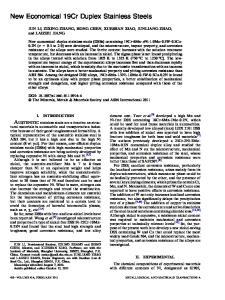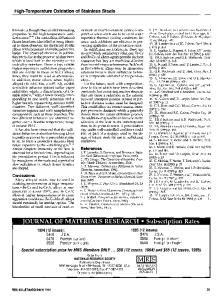Fe-Cr-Mn microduplex ferritic-martensitic stainless steels
- PDF / 702,177 Bytes
- 5 Pages / 612 x 792 pts (letter) Page_size
- 0 Downloads / 346 Views
T H E m e c h a n i c a l r e s p o n s e of duplex f e r r i t i c - m a r tensitic s t a i n l e s s s t e e l s t r u c t u r e s has been evaluated in a number of investigations. F e r r i t e has been obs e r v e d to lower the impact strength of m a r t e n s i t e in both wrought and welded s t r u c t u r e s . l - ~ It has been shown that the f e r r i t e phase is the s i t e of p r e m a t u r e p l a s t i c flow and f r a c t u r e . 4 Conversely, alloy and p r o cess design has long r e f l e c t e d the view that s m a l l amounts of m a r t e n s i t e reduce the impact strength of wrought or welded f e r r i t e . However, when the m a r t e n s i t i e phase, through i n c r e a s e d Ni content and i n t e r s t i t i a l control, is much tougher than the f e r r i t e , it has been c l e a r l y d e m o n s t r a t e d that a f e r r i t i c - m a r t e n s i t i c s t r u c t u r e is c o n s i d e r a b l y tougher than the f e r r i t e alone. ~ The m a r t e n s i t i c constituent a p p e a r s to thwart c r a c k initiation as well as c r a c k propagation. The tensile p r o p e r t i e s of the duplex f e r r i t i c - m a r tensitic alloys provide an a t t r a c t i v e c o m p r o m i s e between the high strength and low elongation of the m a r tensitic s t a i n l e s s s t e e l s and the low strength and much higher elongation o b s e r v e d with the f e r r i t i c g r a d e s . Of course, such c o m p r o m i s e d p r o p e r t i e s can be achieved by t e m p e r i n g the m a r t e n s i t i c a l l o y s and cold working the f e r r i t i c alloys. These additional p r o c e s s steps can be inconvenient and, in any event, the developed p r o p e r t i e s a r e d e s t r o y e d by welding. A r e l a tively stable duplex f e r r i t i c - m a r t e n s i t i c s t r u c t u r e p r o v i d e s , in principle, a much more efficient b a s i s for i n t e r m e d i a t e strength alloy design. The work of Hayden and F l o r e e n I involved s e v e r a l such alloys. F o r example, an F e - 2 0 C r - 4 N i , Ti s t a b i l i z e d alloy developed 63 pct f e r r i t e - 3 7 pct m a r t e n s i t e upon a i r cooling from 925~ This microduplex s t r u c ture d i s p l a y e d yield and t e n s i l e s t r e n g t h s of 470 MPa (68 ksi) and 635 MPa (92 ksi), r e s p e c t i v e l y , coupled with a CVN t r a n s i t i o n t e m p e r a t u r e o f - 130~ The compositions at the ends of the tie line were a p p r o x i mately F e - 2 4 C r - 3 N i ( f e r r i t e ) and F e - 1 6 C r - 6 N i ( m a r -
tensite). Other microduplex F e - C r - N i compositions have been studied by Aggen with and without Ti s t a bilization. 5 In general, the p r i n c i p a l drawback to these F e - C r - N i microduplex f e r r i t i c - m a r t e n s i t i c a l l o y s is the rapid variation in phase balance in the range from 700 to 900~ This behavior is m o r e pronounced in the absence of Ti and is c l e a r l y suggested by the pseudob i n a r y Fe(3 pct N i ) - C r d i a g r a m shown in Fig. 1
Data Loading...











